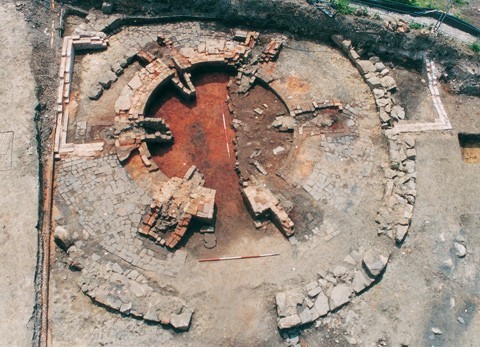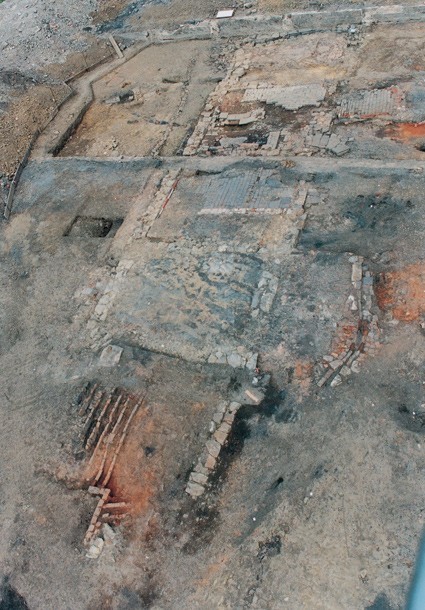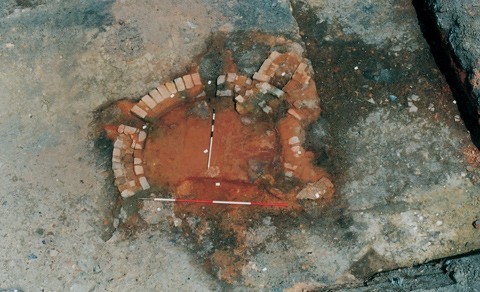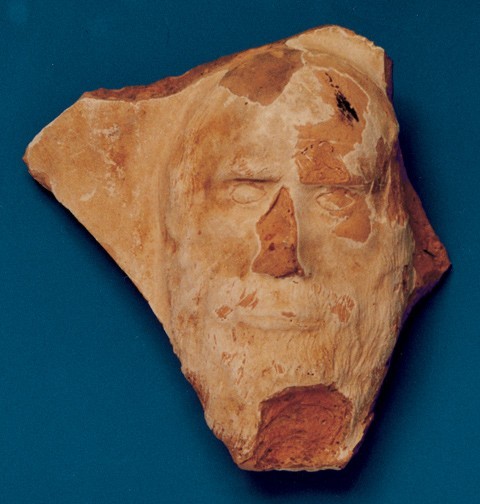
Oblique view of the Lewis kiln, Buckley, showing walk-in entrance, fireboxes, alternating brick flooring, and surrounding hovel wall base. Scale bars each measure 2m (approximately 6.5'). (All photos, courtesy Earthworks Archaeological Services.)

The potters’ cottage and workshop, comprising five individual rooms. The possible drying floor lies at the bottom left of this photograph. Scale bar measures 2m.

The remains of the second kiln uncovered during the excavations. Scale bars measure 1m (approximately 3.3') and 2m.

Face fragment, Lewis Pottery Complex, Buckley, North Wales, mid-eighteenth to nineteenth century. Biscuit-fired earthenware. One of the most unusual sherds recovered during the excavations, it bears an applied molded bearded face and is coated with white clay slip.
In March 2000, an archaeological evaluation was carried out by Earthworks Archaeological Services on the site of a proposed residential development in Buckley, Flintshire, North Wales. At the time of the evaluation the site was unoccupied waste ground but had been used as a timber yard until recently. Archaeological investigations elsewhere within the Buckley area have produced evidence of structures associated with the pottery industry dating from the seventeenth to nineteenth centuries.[1] Documentation relating to the site indicated occupation over time by various members of the Lewis family, a local family of potters. Further, several maps from the mid-eighteenth and nineteenth centuries clearly show the presence of a circular kiln structure and adjacent building, probably a cottage or workshop.
Four linear trenches were excavated as part of the evaluation exercise. Two trenches were positioned strategically in order to evaluate the presumed location of the kiln structure and associated building; the remaining two trenches were located speculatively. The well-preserved remains of the base of a circular brick-built kiln and the stone foundations for a second structure were positively identified. The results clearly warranted full excavation prior to construction, and during the summer of 2000, an area measuring approximately 65.6' x 131' was excavated.
The base of the kiln was almost totally exposed during full excavation; the small part left unexposed was not threatened by the development. The kiln structure, probably of beehive type, consisted of a circular brick-built firing chamber, 3.2' in diameter, with an internal floor of baked clay and a single walk-in entrance. Six fireboxes, each protruding a further 4.6' from the chamber, were spaced evenly around its circumference. Alternating brick and clay floors lay between the fireboxes, the brick flooring presumably used to provide a working surface upon which to stock fuel for firing (fig. 1). An outer circular stone-built wall foundation, the hovel wall, surrounded the firing chamber and measured 38.7' in diameter.
To the northwest of the kiln lay the remains of the associated building visible on cartographic sources and identified during the field evaluation. This structure measured 72.2' x 18.4' and consisted of four individual rooms with a possible fifth at its southern end. This fifth room, or annex, contained a number of rows of brick laid upright on their sides; the clay deposit beneath them showed signs of heating (fig. 2). This enigmatic feature may have formed part of a drying floor on which the pottery was gradually and partially dried before being transferred to the kiln for firing. Comparisons need to be sought in order to assist in the interpretation of this feature. The remaining rooms would have formed both accommodations—a brick and stone hearth was encountered—and workshop/storage space to prepare and stock the pottery vessels produced.
The remains of a second brick-built kiln of diminutive proportions were found to the east of the potters’ workshop (fig. 3). This kiln measured a mere 8.2' in diameter and displayed evidence of six fireboxes each protruding approximately 2' further. This small kiln may have been used for experimental firing purposes or to produce finer products.
A large quantity of pottery wasters and kiln furniture was recovered from the soils within the pottery complex; this material has allowed the characterization of the vessel types and forms produced on the site and the means by which they were both stacked and fired. The Lewis pottery manufactured a variety of black and brown lead-glazed red fabric vessels that included large bowls and dishes, round-bodied and straight-sided mugs, storage jars, and chamber pots, together with white slip decorated bowls, dishes, and mugs. Industrial vessels in the form of white lead extraction pots were also recovered from the site, as well as molded architectural fragments and glazed roofing ridge tiles.
Of the more unusual ceramic items recovered was a fragment from a possible ornamental vessel with an applied molded face of a bearded man with a high forehead and longish hair (fig. 4). This unusual vessel had been biscuit fired and coated in a white slip but had never reached its second, or glost, firing. Only a single example of this type was found, and it may be reasonably assumed that it was not typical of the vessel types being produced. The kiln furniture recovered included large cylindrical saggars with pierced walls, crescent-shaped spacers, small pyramid-shaped spacers, and crude pillow spacers formed by merely squeezing a piece of clay within the fist. Many examples still bear the fingerprints and nail marks of the potters.
Activity on the site earlier than the mid-eighteenth century also became evident during the course of the excavation. Encountered was a small circular hearth-like feature, together with possibly contemporary and associated wall foundations. The hearth feature was subject to archaeomagnetic dating techniques returning a “last firing” date of between 1660 and 1690. Gullies were also found containing black-glazed and trailed slipware vessels (although seemingly not wasters), together with stamped clay tobacco pipes datable to the latter decades of the seventeenth century. A pit, partially sealed beneath the hovel wall of the large kiln, produced wasters that included a black-glazed bowl and a spouted pipkin suggestive of earlier manufacture on the site, possibly during the late seventeenth or early eighteenth century.
Following completion of the archaeological excavation, much of the pottery complex, including the remains of the kiln, was re-buried and preserved beneath a protective layer of stone. Examination of the remains of the Lewis pottery by future generations will thus be possible. Meanwhile, work continues upon the data recovered, not least the sheer volume of pottery, and it is anticipated that the forthcoming report will add to our understanding of the vessel forms, kiln technology, distribution (perhaps even across the Atlantic), and the techniques and skills employed by the Buckley potters of yesteryear.
Leigh J. Dodd, BSc.AIFA
Senior Archaeologist
Earthworks Archaeological Services
<L.Dodd@btinternet.com>
Robina McNeil, “Excavations at Buckley,” Archaeology in Clwyd 7 (1984): 20–21.
